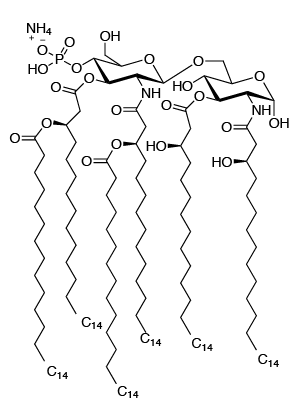MPLAs
-
Cat.code:
tlrl-mpls
- Documents
ABOUT
TLR4 Agonist - Synthetic monophosphoryl lipid A
Synthetic lipid A from E. coli serotype R515 (MPLAs) is a monophosphoryl lipid A with 6 fatty acyl groups. It is structurally very similar to natural MPLA except that natural MPLA contains a mixture of 5, 6, and 7 acyl lipid A. The number of fatty acids is a major determinant of the immunogenicity of endotoxin.
Synthetic E. coli lipid A activates TLR4 but does not activate TLR2 even at high concentrations, reflecting its high purity. This product can be used for immunomodulatory studies as it is a pure monophosphoryl lipid A containing 6 fatty acyl groups.
InvivoGen also offers MPLA Synthetic VacciGrade™, a high-quality pre-clinical grade suited for in vivo studies.
Background
Monophosphoryl Lipid A (MPLA) is a low-toxicity derivative of lipopolysaccharide (LPS) that retains the immunologically active lipid A portion of the parent molecule. Both LPS and MPLA are TLR4 agonists, but they signal through different adaptors, MyD88 and TRIF, respectively1, 2. The reduced toxicity of MPLA is attributed to the preferential recruitment of TRIF upon TLR4 activation, resulting in decreased induction of inflammatory cytokines. MPLA is widely used as a vaccine adjuvant due to its potent immunomodulatory properties and low inflammatory toxicity1, 2.
1. Sastry M. et al., 2017. Adjuvants and the vaccine response to the DS-Cav1stabilized fusion glycoprotein of respiratory syncytial virus. PLoS One. 12(10):e0186854.
2. Cui W. et al., 2014. TLR4 ligands lipopolysaccharide and monophosphoryl lipid a differentially regulate effector and memory CD8+ T Cell differentiation. J Immunol. 192(9):4221-32.
3. Steimle A. et al., 2017. Structure and function: Lipid A modifications in commensals and pathogens. Int J Med Microbiol. 306(5):290-301.
All products are for internal research use only, and not for human or veterinary use.
SPECIFICATIONS
Specifications
TLR4
C96H184N3O22P
300 pg/ml - 100 ng/ml
1 mg/ml in DMSO
TLR4 activation
TLR4 activation
Each lot is functionally tested and validated.
The absence of bacterial contamination (e.g. lipoproteins) has been confirmed using HEK-Blue™ TLR2 cells.
CONTENTS
Contents
-
Product:MPLAs
-
Cat code:tlrl-mpls
-
Quantity:1 mg
Shipping & Storage
- Shipping method: Room temperature
- -20°C
- Avoid repeated freeze-thaw cycles
Storage:
Caution:
DOCUMENTS
Documents
Technical Data Sheet
Safety Data Sheet
Certificate of analysis
Need a CoA ?





